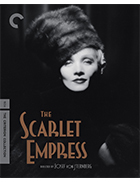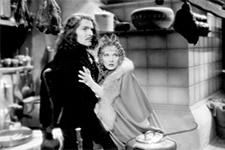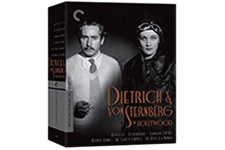| Director: Josef von Sternberg | | Screenplay: Manuel Komroff (based on the diaries of Catherine II) | | Stars: Marlene Dietrich (Sophia Frederica / Catherine II), John Lodge (Count Alexei), Sam Jaffe (Grand Duke Peter), Louise Dresser (Empress Elizabeth), Maria Sieber (Sophia as a Child), C. Aubrey Smith (Prince August), Ruthelma Stevens (Countess Elizabeth) | | MPAA Rating: NR | | Year of Release: 1934 | | Country: U.S. |  |
|  Josef von Sternberg’s fifth Hollywood collaboration with screen siren Marlene Dietrich, The Scarlet Empress, is a dense, visually astounding portrait of a woman evolving from an innocent, inexperienced, and idealistic girl to a shrewd, calculating empress who uses all the tools at her disposal, including her immense sexuality, to gain absolute power. Unfortunately, Sternberg’s visual tableaux are so provocative and overwhelming that the nuanced depiction of young Sophia Frederica’s evolution into Catherine II, also known as Catherine the Great, empress of Russia, gets buried. As a critic wrote in his 1934 review in The New York Times, the actors “seem to lose their hold on humanity under Mr. von Sternberg’s narcotic influence, and become like people struggling helplessly in a dream.” The story is ostensibly a biography of Catherine II (Marlene Dietrich), originally named Sophia Federica, a German princess who was born in the mid-18th century. Early in her life, she was married off to Grand Duke Peter III (Sam Jaffe) of Russia, described in one of the film’s less-than-subtle title cards as “a royal half-wit.” Inexperienced in the deception, intrigue, and plotting of royal life, Catherine is astounded that Empress Elizabeth (Louise Dresser), Peter III’s mother, brought her to Russia for the sole purpose of bearing a male child who could succeed her. She soon learns how to gain power, though, especially by wielding her burgeoning sexuality. While Peter loses influence and popularity with his insane, violent tactics (including mass executions), Catherine silently gets the entire Russian army on her side by taking most of them into her bed. In this way, the film makes an interesting juxtaposition of sex and violence as tools for accumulating power, and its infatuation with Catherine’s sexuality (not to mention a few brief glimpses of female nudity) makes it clear that this was a film that slipped through the Production Code approval process before it was fully enforced in late 1934. Of course, during the first viewing, the more subtle aspects of Catherine’s immense transformation is lost in von Sternberg’s excessive mis en scene, which is not surprising when you consider that, in his 1965 autobiography, he likened his actors to mere spots on a canvas. In The Scarlet Empress, von Sternberg goes over the top, filling the barbaric 18th-century Russian court with an assortment of gargoyles and statues of men carved in various stages of pain and anguish, their distorted faces filling every corner of the frame, glaring and moaning in silence, making it impossible to get away from them. They support stair banisters, the ceiling, and even form the backs of chairs. Elizabeth’s mirror is overlooked by a leering demon, complete with horns and wings, and Peter’s throne is a giant griffin, the arm rests fashioned out of its extended claws. Pain is one of the central motifs of The Scarlet Empress, beginning with a brutal sequence in which the young Sophia hears stories about the great Russian tsars Peter the Great and Ivan the Terrible and imagines a lengthy succession of tortures, beatings, and executions, climaxing in a shot of a man helplessly flailing upside down as he is used as a clapper in a giant bell. These portraits of human suffering are echoed through the rest of the film’s statue-filled mis en scene, which emphasizes the rawness and violence of the Russian empire at that time. The visual nature of the film is further complicated with candelabras, pillars, tapestries, and lace curtains, which are everywhere, breaking up and fragmenting the light into patches and streaks of brightness and shadow that are as evocative as anything to be found in German Expressionism. Not a single shadow is misplaced, and Sternberg’s careful compositions tend to work against the drama in the film, as he more often than not privileges the set design and lighting over the humans—with the exception of Dietrich. By this point, Sternberg had perfected the art of capturing her beautiful visage on film, and he doesn’t disappoint here. Unlike her other portrayals of sexually domineering women, here Dietrich plays what are essentially two roles: the naive Sophia Francesca and the powerful Catherine. That Dietrich’s fine performance is often overshadowed by some of Sternberg’s visual excesses is unfortunate. Nevertheless, a second viewing of the film allows one to fully appreciate her work and the way Sternberg’s lighting and camera angles emphasize her innocence in the first half of the film and her cunning in the second. Kudos should also go to Sam Jaffe who, in his first film role, is one of the true delights in The Scarlet Empress. He plays Peter as a leering snake, his face almost skull-like, his eyes wide, but completely vacant, his mouth almost impossibly stretched into what appears to be a constantly forced grin. It is a mannered performance, to be sure, but also shocking in the way he morphs from infantile to brutal once he takes the throne. | The Scarlet Empress Criterion Collection Blu-ray |  The Scarlet Empress is available exclusively as part of the Criterion Collection’s “Dietrich & Von Sternberg in Hollywood” boxset, which also includes Morocco (1930), Dishonored (1931), Shanghai Express (1932), Blonde Venus (1932), and The Devil Is a Woman (1935). The Scarlet Empress is available exclusively as part of the Criterion Collection’s “Dietrich & Von Sternberg in Hollywood” boxset, which also includes Morocco (1930), Dishonored (1931), Shanghai Express (1932), Blonde Venus (1932), and The Devil Is a Woman (1935). | | Aspect Ratio | 1.33:1 | | Audio | English Linear PCM 1.0 monaural | | Subtitles | English | | Supplements | New interviews with film scholars Janet Bergstrom and Homay King; director Josef von Sternberg’s son, Nicholas; Deutsche Kinemathek curator Silke Ronneburg; and costume designer and historian Deborah Nadoolman LandisNew documentary about actor Marlene Dietrich’s German origins, featuring film scholars Gerd Gemünden and Noah IsenbergNew documentary on Dietrich’s status as a feminist icon, featuring film scholars Mary Desjardins, Amy Lawrence, and Patricia WhiteThe Legionnaire and the Lady, a 1936 Lux Radio Theatre adaptation of Morocco, featuring Dietrich and actor Clark GableNew video essay by critics Cristina Álvarez López and Adrian MartinThe Fashion Side of Hollywood, a 1935 publicity short featuring Dietrich and costume designer Travis BantonTelevision interview with Dietrich from 1971Insert book featuring essays by critics Imogen Sara Smith, Gary Giddins, and Farran Smith Nehme | | Distributor | The Criterion Collection | | SRP | $124.95 | | Release Date | July 3, 2018 | | | COMMENTS | | Calling Criterion’s Dietrich & Von Sternberg in Hollywood a major release doesn’t quite do it justice, as the set pulls together six major films that represent the near entirety of one of the most important, fascinating, and influential director-actor collaborations in film history. Not only does the Criterion boxset include all six of the films Marlene Dietrich and Josef von Sternberg made together during their years working for Paramount (the only exclusion is 1930’s The Blue Angel, which was a German production distributed in the U.S. by Paramount), but there is a host of extras that contextualize the films historically and aesthetically and help us better appreciate the artistry of Dietrich and von Sternberg. In terms of sound and image, all six films are in the best condition they’ve ever been in on home video. Given that all of the films were made between 1930 and 1935, they certainly reflect the style and quality of filmstock, cameras, and sound recording technologies at that time, which is how it should be. Morocco and Dishonored, both of which were early synchronized sound films, are both presented in their proper 1.19:1 aspect ratio, which reflects the compromise made at the time to use the silent-era parameters of 35mm film stock and take away from of the image to make room for the optical soundtrack. The other four films are presented in their 1.33:1 or 1.37:1 Academy aspect ratio. Morocco was transferred in 2K from a 35mm safety fine-grain held by the UCLA Film & Television Archive; Dishonored, Blonde Venus, and The Scarlet Empress were all transferred in 4K from 35mm nitrate prints held by the UCLA Film & Television Archive; Shanghai Express was transferred in 4K from a 35mm duplicate negative and a composite fine-grain print by Universal Pictures; and The Devil Is a Woman was also transferred in 4K from a 35mm safety duplicate negative. Extensive digital restoration was performed on all six films, leaving them as clean and blemish-free as one could possibly expect. The image quality of the films gradually improves with each one, not necessarily because of the transfers, but because of the improvements in film stock and the slightly increased resolution of the later sound films. Morocco definitely looks the softest and the grainiest, while the later films have a much sharper appearance, with stronger contrast and finer detail, albeit with plenty of film grain still present. Criterion had previously released The Scarlet Empress on DVD, and the comparison between that transfer and the new one is substantial, with the new high-definition presentation bearing remarkably better depth and detail and with none of the visible wear and tear of the earlier transfer. Like the image quality, the sound quality of each film is very good, although representative of the technological limitations of the time. The monaural soundtrack for Morocco was mastered from a 35mm safety fine-grain; Dishonored, Blonde Venus, and The Scarlet Empress’s soundtracks were mastered from their respective 35mm nitrate prints, while The Devil Is a Woman track was mastered from a 35mm soundtrack positive. And, finally, Shanghai Express’s soundtrack was mastered and restored by Universal from a 35mm optical soundtrack negative. The supplements, which together comprise hours of material, are scattered across the six discs. The Morocco disc features “Weimar on the Pacific” (30 min.), a detailed featurette about Dietrich’s German origins that features interviews with film scholars Gerd Gemünden and Noah Isenberg; “Crazy Love,” a 31-minute interview with film scholar Janet Bergstrom about Morocco’s production and reception; “The Real Amy Jolly” (20 min.), an interview with Deutsche Kinemathek curator Silke Ronneburg (who shows up in another featurette on the Blonde Venus disc) about the real-life woman on whom the Dietrich character is based; and “The Legionnaire and the Lady,” a 60-minute Lux Radio Theatre adaptation of Morocco from 1936 that features Dietrich reprising her role and Clark Gable standing in for Gary Cooper. The Dishonored disc includes “Bodies and Spaces, Fabric and Light” (30 min.), an absolutely fascinating video essay by film scholars Cristina Alvarez Lopez and Adrian Martin about von Sternberg’s unique visual style; “Dietrich Icon” (20 min.), a featurette in which film scholars Mary Desjardine, Amy Lawrence, and Patricia White discuss how Dietrich became a complex and subversive Hollywood icon in her collaboration with von Sternberg; and a video interview with von Sternberg’s son, Nicholas, from 2014. The Shanghai Express disc includes only one supplement, but it is a great one: a 23-minute interview with film scholar Homay King, author of Lost in Translation: Orientalism, Cinema, and the Enigmatic Signifier, about the film’s complicated and, in some regards, regressive depiction of the “exotic” East. The Blonde Venus disc includes “The Fashion Side of Hollywood” (10 min.), a publicity short from 1935 that features Dietrich modeling clothes designed for her by costume designer Travis Banton, and “The Marlene Dietrich Collection” (15 min.), a 15-minute featurette about the immense collection of Dietrich memorabilia housed at the Deutsche Kinemathek in Berlin, featuring an interview with curator Silke Ronneburg. The Scarlet Empress and The Devil Is a Woman discs also have only one supplement each: On the former, we have “Marlene Dietrich in Denmark” (29 min.), a retrospective interview with Dietrich from 1971 that aired on Swedish television, while on the latter we have the audio from a 78 rpm promotional disc of the song “If It Isn’t Pain,” which had to be cut from the film due to restrictions by the Production Code Administration (PCA). Finally, the boxset is packaged with a thick insert book that features essays on each film by critics Imogen Sara Smith, Gary Giddins, and Farran Smith Nehme. |
Copyright © 2018 James Kendrick Thoughts? E-mail James Kendrick All images copyright © The Criterion Collection |



 (3)
(3)

 The Scarlet Empress is available exclusively as part of the Criterion Collection’s “Dietrich & Von Sternberg in Hollywood” boxset, which also includes Morocco (1930), Dishonored (1931), Shanghai Express (1932), Blonde Venus (1932), and The Devil Is a Woman (1935).
The Scarlet Empress is available exclusively as part of the Criterion Collection’s “Dietrich & Von Sternberg in Hollywood” boxset, which also includes Morocco (1930), Dishonored (1931), Shanghai Express (1932), Blonde Venus (1932), and The Devil Is a Woman (1935).